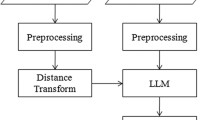Abstract
The hippocampus segmentation plays a crucial role in analyzing brain activities, which is a widely used biomarker for Alzheimer’s disease, epilepsy, and schizophrenia diagnosis. The automatic segmentation of hippocampus is a complex task, because of low signal contrast, small structural size, and insufficient image resolution. The automatic hippocampus segmentation utilizing magnetic resonance imaging (MRI) is effective in clinical diagnosis and neuro-science research. In this manuscript, a new automatic segmentation model in MRI is implemented for hippocampus segmentation. Initially, the MRI brain images are collected from Neuroimaging Tools and Resources Collaboratory (NITRC) and the Open Access Series of Imaging Studies (OASIS) databases. Further, color normalization technique is employed for improving the visual ability, and reduce the impulse noise and machinery noise (mechanical and electrical noises) in the image. Finally, the Fuzzy C Means-based Level Set Local Ternary Pattern with Enhanced Edge Indicator (FCM-LSLTPEEI) is proposed for hippocampus segmentation. The proposed model combines FCM and EEI functions in the LSLTP model, where the important phase is to adapt the EEI function effectively with the LSLTP. The experimental outcomes revealed that the proposed FCM-LSLTPEEI model obtained 98.90% and 99.01% of accuracy on the OASIS and NITRC databases, which are superior compared to the traditional models.









Similar content being viewed by others
Data Availability
The datasets generated during and/or analyzed during the current study are available in the NITRC database available link: https://www.nitrc.org/projects/hippseg_2011/, OASIS database available link: https://www.oasis-brains.org/
References
D. Carmo, B. Silva, C. Yasuda, L. Rittner, R. Lotufo, A.D.N. Initiative, Hippocampus segmentation on epilepsy and Alzheimer’s disease studies with multiple convolutional neural networks. Heliyon 7(2), e06226 (2021). https://doi.org/10.1016/j.heliyon.2021.e06226
Y. Liu, Z. Yan, A combined deep-learning and Lattice Boltzmann model for segmentation of the hippocampus in MRI. Sensors 20(13), 3628 (2020). https://doi.org/10.3390/s20133628
Y. Shao, J. Kim, Y. Gao, Q. Wang, W. Lin, D. Shen, Hippocampal segmentation from longitudinal infant brain MR images via classification-guided boundary regression. IEEE Access 7, 33728–33740 (2019). https://doi.org/10.1109/ACCESS.2019.2904143
Y. Shi, K. Cheng, Z. Liu, Hippocampal subfields segmentation in brain MR images using generative adversarial networks. Biomed. Eng. Online 18, 5 (2019). https://doi.org/10.1186/s12938-019-0623-8
S. Vijayalakshmi, Savita, An automated enhanced FCM based hippocampus segmentation. Ann. Rom. Soc. Cell Biol. 25(1), 1861–1871 (2021)
S. Pang, J. Jiang, Z. Lu, X. Li, W. Yang, M. Huang, Y. Zhang, Y. Feng, W. Huang, Q. Feng, Hippocampus segmentation based on local linear map**. Sci. Rep. 7, 45501 (2017). https://doi.org/10.1038/srep45501
X. Jiang, Z. Zhou, X. Ding, X. Deng, L. Zou, B. Li, Level set based hippocampus segmentation in MR images with improved initialization using region growing. Comput. Math. Methods Med.. Math. Methods Med. 2017, 5256346 (2017). https://doi.org/10.1155/2017/5256346
L. Palumbo, P. Bosco, M.E. Fantacci, E. Ferrari, P. Oliva, G. Spera, A. Retico, Evaluation of the intra-and inter-method agreement of brain MRI segmentation software packages: a comparison between SPM12 and FreeSurfer v6. 0. Phys. Med. 64, 261–272 (2019). https://doi.org/10.1016/j.ejmp.2019.07.016
Z. Yang, X. Zhuang, V. Mishra, K. Sreenivasan, D. Cordes, CAST: a multi-scale convolutional neural network based automated hippocampal subfield segmentation toolbox. Neuroimage 218, 116947 (2020). https://doi.org/10.1016/j.neuroimage.2020.116947
S. Nasser, M. Naoui, G. Belalem, S. Mahmoudi, Semantic Segmentation of Hippocampal Subregions with U-Net Architecture. Int. J. E-Health Med. Commun. (IJEHMC) 12(6), 1–20 (2021). https://doi.org/10.4018/IJEHMC.20211101.oa4
Funding
This research received no external funding.
Author information
Authors and Affiliations
Corresponding author
Ethics declarations
Conflict of interest
The authors declare that they have no conflict of interest.
Ethical Approval
I/We declare that the work submitted for publication is original, previously unpublished in English or any other language(s), and not under consideration for publication elsewhere.
Consent for Publication
I certify that all the authors have approved the paper for release and are in agreement with its content.
Additional information
Publisher's Note
Springer Nature remains neutral with regard to jurisdictional claims in published maps and institutional affiliations.
Rights and permissions
Springer Nature or its licensor (e.g. a society or other partner) holds exclusive rights to this article under a publishing agreement with the author(s) or other rightsholder(s); author self-archiving of the accepted manuscript version of this article is solely governed by the terms of such publishing agreement and applicable law.
About this article
Cite this article
Kaka, J.R., Prasad, K.S. Hippocampus Segmentation Using Fuzzy C Means-Based Level Set Local Ternary Pattern with Enhanced Edge Indicator. J. Inst. Eng. India Ser. B 105, 565–574 (2024). https://doi.org/10.1007/s40031-024-00989-1
Received:
Accepted:
Published:
Issue Date:
DOI: https://doi.org/10.1007/s40031-024-00989-1




